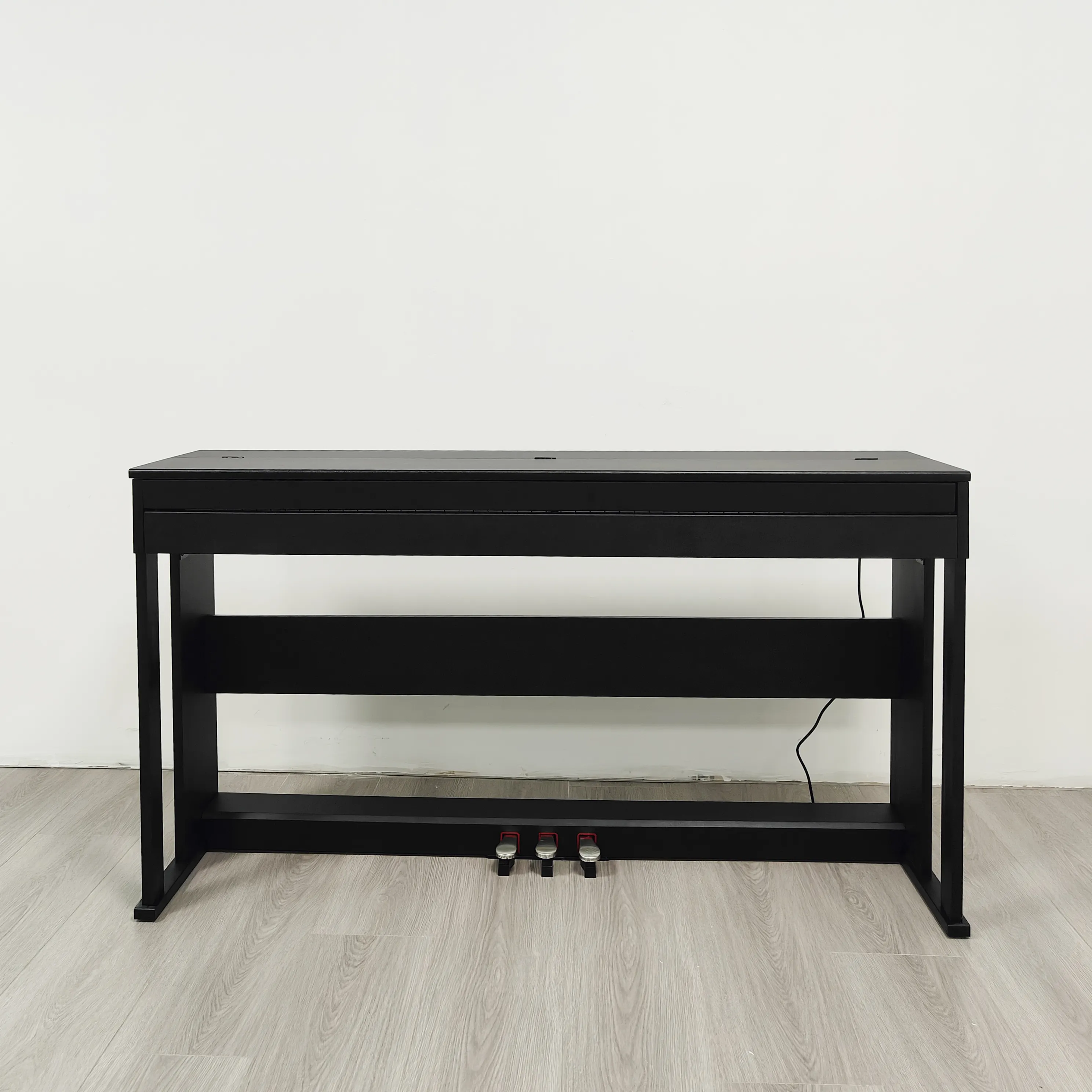في نمط الحياة السريع اليوم، تُعد راحة وملاءمة البيانو الرقمي اجعلها استثمارًا ذكيًا للمتعلمين الموسيقيين في المنزل. سواء كنت والدًا يدعم أولى خطوات طفلك في تعلم الموسيقى أو بالغًا تسعى لإعادة إشعال شغفك بالعزف، فإن اختيار الآلة الموسيقية المناسبة أمرٌ بالغ الأهمية. البيانو الرقمي يوفر شعور الآلة الصوتية مع ميزات مصممة لتتناسب مع نمط الحياة الحديث. بفضل تصميمه المدمج، ودعم سماعات الرأس، والأدوات التعليمية المدمجة، أصبحت البيانو الرقمية الاختيار المفضل لممارسة العزف في المنزل.
على عكس pianos الآكوستيك التقليدية، فإن البيانو الرقمي تم تصميمه مع التركيز على كفاءة المساحة، مما يجعله مثاليًا للشقق أو المنازل التي تكون فيها المساحة محدودة. يمكن وضع معظم النماذج بسهولة في زاوية أو مقابل جدار أو حتى تخزينها في خزانة. وعلى الرغم من الحجم الصغير، إلا أن البيانو الرقمي لا يزال يوفر لوحة مفاتيح كاملة مع أزرار مُوزَّنة لضمان تجربة عزف أصيلة.
مزاولة أخرى لامتلاك بيانو رقمي هي قابلية نقله بسهولة. هل تحتاج إلى نقل بيانو الخاص من غرفة إلى أخرى أو حتى أخذها إلى منزل صديق؟ مع البيانو الرقمي، الأمر ببساطة يقتصر على فصل الاتصال وحمله. تجعل هذه الدرجة من الحركة ملكية البيانو الرقمي جذابة للغاية للطلاب الذين قد يحتاجون إلى الانتقال بشكل متكرر أو لأولئك الذين يفضلون بيئات تدريب مرنة.
تأتي العديد من طرازات البيانو الرقمية الحديثة مزودة بمنفذ USB وتقنية الاتصال MIDI، مما يسمح لك بتوصيل آلة العزف الخاصة بك بتطبيقات تعلم الموسيقى أو الحواسيب أو أجهزة رقمية أخرى. تدعم هذه الميزة التعلم المستقل وتمكن المستخدمين من تلقي ملاحظات فورية أو المشاركة في دروس افتراضية، وهي طريقة فعالة لتعزيز الدافع وتسريع التقدم.
تقدم المكتبة الصوتية المضمنة في معظم طرازات البيانو الرقمية مجموعة متنوعة من أصوات الآلات الموسيقية التي تتجاوز نغمة البيانو القياسية. تتضمن هذه المكتبة أصواتاً مثل الكلافيكورد وال-organs (الأورغن) والآلات الوترية والسنثيسايزر (المولد الإلكتروني للأصوات)، مما يمكّنك من استكشاف أنواع موسيقية وأساليب مختلفة بسهولة. ويجعل هذا كل جلسة تدريب أكثر ديناميكية وإرضاءً إبداعياً، مع التركيز في الوقت نفسه على المهارات الأساسية للبيانو.

تُعد إحدى أكثر ميزات البيانو الرقمي تقديرًا هي منفذ سماعات الرأس. يسمح لك التدريب بصمت بالتركيز بعمق دون إزعاج الآخرين في منزلك. وهذا يعني أنه يمكنك العزف مبكرًا في الصباح أو متأخرًا في الليل، مما يجعل التدريب اليومي أكثر اتساقًا وسهولة الوصول إليه بغض النظر عن جدول أفراد أسرتك.
على عكس البيانو الآكوستيكي، يتيح لك البيانو الرقمي التحكم في الصوت بدقة. مما يتيح لك التدرب براحة في الأماكن المشتركة، حيث قد يكون الضجيج المفرط مشكلة. يدعم التحكم في الصوت التعلم الخالي من التوتر ويشجع على جلسات أطول، مما يؤدي في النهاية إلى تطوير أفضل للمهارات.
من أبرز المزايا الاقتصادية لامتلاك بيانو رقمي هو أنه يلغي الحاجة إلى تنغيم دوري. على عكس pianos الصوتية، التي تتطلب تنغيمًا احترافيًا مرة أو مرتين في السنة على الأقل للحفاظ على سلامتها الصوتية، تم تصميم pianos الرقمية لتوفير صوت ثابت دون أي تعديلات مستمرة. وذلك لأن أصواتها تُؤخذ كعينات رقمية وتُعاد إنتاجها دون تأثر بالرطوبة أو درجة الحرارة أو الاستخدام المتكرر. بمرور الوقت، يمكن أن تصبح تكاليف تنغيم البيانو الصوتي مرتفعة بشكل كبير، مما يجعل النماذج الرقمية خيارًا أكثر اقتصادية على المدى الطويل. هذا التصميم الذي يعتمد على القليل من الصيانة يجذب بشكل خاص المنازل المزدحمة أو المؤسسات التعليمية أو الموسيقيين الهواة الذين يرغبون في التركيز على العزف بدلًا من الصيانة. كما أنه يوفر راحة بال، مع العلم أن الآلة دائمًا جاهزة لأداء متميز دون تكلفة أو جهد إضافي.
تم تصميم مكونات البيانو الرقمي بحيث تكون متينة وقوية، مما يسمح لها بالتحمل ضد أضرار الاستخدام اليومي والتغيرات البيئية بشكل أفضل بكثير من pianos الصوتية. على عكس الآلات التقليدية، التي تكون حساسة لتغيرات الرطوبة ودرجة الحرارة - مما يؤدي إلى التشويه أو فقدان النغمة أو مشاكل ميكانيكية - يحافظ البيانو الرقمي على أداء مستقر بغض النظر عن الظروف المحيطة. تم اختيار الإلكترونيات الداخلية ومواد البناء بشكل خاص لمقاومة البلى الناتج عن التمرين اليومي وحتى النقل العرضي أو الحركة. تضمن هذه الجودة العالية في البناء أن تقدم pianos الرقمية صوتًا ووظائف ثابتة على مر الزمن. بالنسبة للطلاب أو الهواة أو المحترفين الذين يمارسون العزف في المنزل، فإن هذا المستوى من الموثوقية يُعتبر استثمارًا طويل الأجل ذكيًا، حيث يدعم التعلم المستمر والتطور الموسيقي دون القلق بشأن الصيانة المتكررة أو الأضرار البيئية.
تقدم معظم طرز pianos الرقمية خاصية التسجيل المدمجة. يتيح لك ذلك التقاط جلسات التدريب الخاصة بك وتقييم تقدمك. يمكنك تحديد المجالات التي تحتاج إلى التحسين، وتطوير أسلوب عزف أفضل، أو حتى تأليف قطع موسيقية أصلية. تحوّل هذه الميزة الروتين العادي للتدرب إلى استكشاف إبداعي.
يدعم piano الرقمي مكبرات الصوت الخارجية، أو المُعدّلات، أو حتى الدمج في محطات الصوت الرقمية. سواء كنت تتدرب للاستمتاع الشخصي أو تستعد لعرض صغير في المنزل، فإن خيارات الاتصال توسّع إمكاناتك الموسيقية. إنها أداة قيمة لأي شخص يرغب في التطور من متعلم إلى عازف محترف.
يُعدّ البيانو الرقمي داعمًا للموسيقيين على اختلاف مستوياتهم، من الأطفال إلى البالغين. تُعدّ الوظائف الصديقة للمبتدئين مثل الكوميترونوم (المُعَدّل الإيقاعي) ووضعيات الدروس والمفاتيح المُضاءة عوامل مُساعدة في خلق تجربة إيجابية للتعلم، في حين تُلبي المزايا المتقدمة مستويات الموسيقيين المتوسطين وحتى المحترفين. وتضمن هذه المرونة أن تظل استثمارك في البيانو ذا صلة وثيقة مع تطوّر مهاراتك.
امتلاك بيانو رقمي يشجع المشاركة الموسيقية في جميع أنحاء المنزل. يمكن للأخوة أو الآباء أن يتناوبوا على التدريب، أو يتعاونوا في أغاني، أو ببساطة يستمتعون بصوت الموسيقى التي تملأ المنزل. إنه يُغذّي ثقافة الإبداع، مما يجعل البيانو الرقمي ليس مجرد آلة، بل نشاط عائلي مشترك.
يستخدم البيانو الرقمي تقنية أخذ نماذج صوتية إلكترونية لمحاكاة صوت البيانو الآلي، كما يوفر مزايا إضافية مثل التحكم في مستوى الصوت ومخرج سماعات الرأس والاتصالات.
مع العناية الجيدة، يمكن لآلة بيانو رقمية عالية الجودة أن تدوم من 10 إلى 20 سنة، ويعتمد ذلك على الاستخدام والصيانة.
نعم، يستخدم العديد من الموسيقيين المحترفين نماذج البيانو الرقمية في التأليف والتدريس وحتى الأداء، خاصة عندما تكون المساحة أو التحكم في الصوت عاملاً مهماً.
تأتي معظم آلات البيانو الرقمية الحديثة بمنافذ USB أو MIDI مما يسمح بتوصيلها بسهولة بالحواسيب والأجهزة اللوحية والهواتف الذكية لأغراض التعلم والتسجيل.